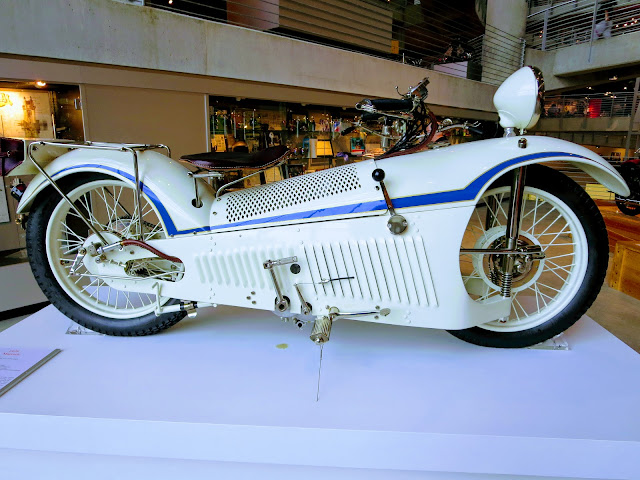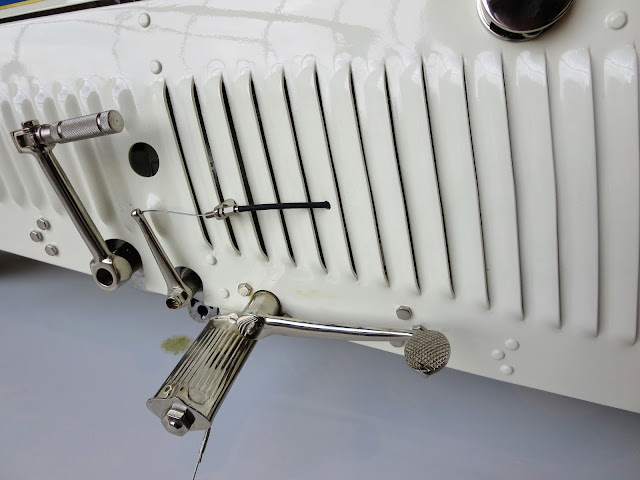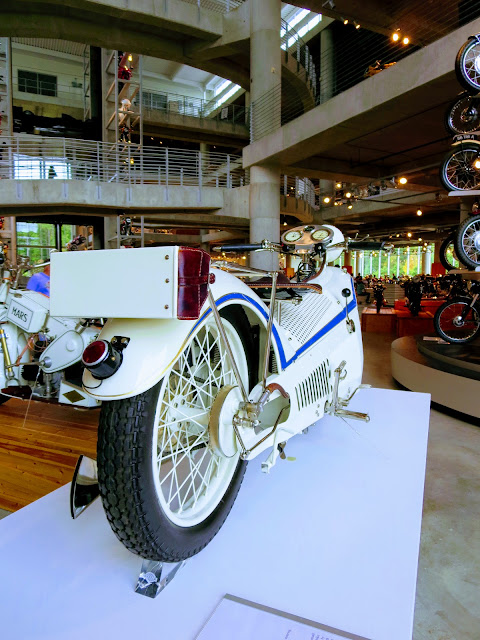It is the 1920s. The heady period following the First World War has, without a doubt, produced some of the most iconic and beautiful European vehicles the world would see until well into the latter half of the 20th century. The futuristic minimalism of Art Deco has superceded the organic forms of Art Nouveau, and set the template for the clean, flowing forms of Streamline Moderne that would follow. Storied marques like Bugatti, Delahaye, Talbot and countless others are producing spectacular automobiles that will define the melding of art and design for decades to come. It is a definition that will be cut short by the economic downturn of the Great Depression and the destruction wrought by the Second World War.
Motorcycles, too, benefit from this all-too brief period of carefree optimism. French marques in particular are flourishing, producing modern and beautifully styled machines that attempt to elevate the motorcycle from mere populist transportation into the realm of luxurious motoring - the likes of which hadn't been seen amongst the crude, noisy, and messy contraptions that defined motorcycling at the turn of the 20th Century.
Amongst these forward-thinking designs one machine in particular has captivated designers and collectors who appreciate how the refinement of the period was applied in the two-wheeled realm. The Majestic is one of the most intriguing of these clean, streamlined motos that, for a brief instant, promised to offer the beauty and style that was associated with the luxurious automotive brands. It was a moment when motorcycles might have caught up to the innovation and grace of the finest cars, but instead the experiment faded into obscurity. It remained a short-lived diversion in the history of the motorcycle, but for a time machines like the Majestic offered something special to riders seeking something more sophisticated.
As is the case with many innovative machines, the Majestic story begins with the vision of a single person. Georges Roy was a French industrialist and engineer born in 1888 who achieved success in the textile business - specifically in knitting and sewing equipment. He was, however, an early adopter of motorcycling at the turn of the 20th Century - reportedly his first machine was a Werner, a Parisian machine that introduced the term "Motocyclette" in 1897.
 |
| Image Source |
 |
| Image Source |
 |
| Image Source |
The result following the failure of the New Motorcycle was the subject of today's profile, the Majestic. It was more radical than the New Motorcycle in terms of styling and design, while being more conservative in its engineering. Despite its fully-enclosed appearance, the bodywork of the Majestic is not structural and the fully unitized monocoque structure of the New Motorcycle was not carried over. The Majestic features a cosmetic shell that encloses the running gear, beneath which which is a pair of underslung square frame rails riveted together with flat bulkheads at the front and rear. Each right angle joint is gusseted for additional strength. It is an arrangement not unlike the body-on-frame automobiles of the era, resulting in a low-slung chassis reminiscent of earlier designs like the Ner-A-Car. Also shared with the Ner-A-Car was a hub-centre steering arrangement. It was unusual but not unprecedented. Roy himself later admitted to being inspired by the Ner-A-Car while designing the Majestic, aiming to create a similar but more elegant "moto-voiture" that offered some automotive elegance and comfort to the rider tired of crude "moto-bicyclettes".
 |
| Image Source |
As common for the time rear suspension was nonexistent, while the front was suspended on a pair of sliding pillars somewhat like the sprung-hub rear ends that would precede swinging arm arrangements. Steering is accomplished via a horizontal rod on the right side, connected to the vertical steering column, which acts upon a curved lever pivoting around the right suspension pillar. The front hub does double duty, serving as the brake drum and the steering mechanism, with a kingpin arrangement stuffed within the wheel bearings that very much resembles a finer and larger interpretation of the Ner-A-Car system. As no outside firms offered anything suitable for the Majestic, this complex hub was manufactured in-house.
 |
| Image Source |
The base price of the Majestic was 5200 Francs for a 350 with chain final drive; an extra 500 Francs netted you optional shaft drive. An additional option that is rarely seen on surviving examples was a fine "craquelure" paint option that was applied by skilled artisans. It involves a process of deliberately screwing up the paint job in the most controlled and flawless way possible, applying a contrasting top coat over a base using incompatible paints that will cause the top coat to crack in a uniform fashion, something like a well-aged oil painting or antique piece of furniture. The result is spectacular - and perhaps a bit tacky, giving the machine the appearance of a lizard skin handbag.
 |
| Image Source Early and late chassis designs. Note the heavy frame rails of the early pattern in the foreground vs the monocoque tub of the later pattern in the background. |
These monocoque machines can be easily distinguished from the earlier Majestics by examining the number and arrangement of the body panels; the earlier beam frame chassis has separate covers over the frame rails and central side panels that are split from the fenders, while the monocoque machines have only a single panel on each side.
Roy's apparent interest in the motorcycle industry began to wane at this point and in 1930 he sold the whole operation to Etablissements Delachanal in Joinville-le-Pont. Delachanal were known for their production of Dollar motorcycles, using the same Chaise powerplants that Roy had put to good use in the New Motorcycle and the Majestic. Unfortunately for Majestic (and fortunately for Roy, who got out of the game while the going was still good) the Great Depression hit Europe hard and in 1931 Delachanal was absorbed into Omnium Métallurgique et Industriel, who were the parent company of Chaise. The Majestic limped along until 1933, when production was ceased due to poor sales and high manufacturing costs. Exact production is unknown but a few hundred examples is probably a safe guess.
Riding the Majestic was unusual for several reasons. Steering was a bit vague, an endemic problem with hub-centre designs to this day, but impeccably stable at speed. It was also agile and light footed in a way that similar machines, like the Ner-A-Car, were not. In an era barely beyond the age of flimsy motorized bicycles with questionable geometry the Majestic would have been a revelation in its refinement, if not a revolution. The relatively low weight, around 350 pounds, carried with a very low centre of gravity made for tidy handling that was more than up to the meagre output offered by the Chaise powerplants. Otherwise it is remarkably unremarkable considering its appearance. It offered all the qualities that were par for the course during that era - usually offered by machines that were far less expensive.
Nowadays the Majestic is heralded as a masterpiece of Art Deco design, a refined and beautiful machine from the gilded age of motoring, something so painfully exquisite that its failure to catch on is a mystery. Or at least that seems to be the consensus among us historians. No one seems to notice that the Majestic is a sheet metal sausage with wheels awkwardly grafted to either end, a goofy oversized spotlamp perched ahead of a set of messy controls stuffed through the bodywork. Nor do they point out that the construction and design of the Majestic is relatively simple and far from the coachbuilt grandeur of similarly praised autos of the period. Finally they not consider that the Majestic was targeting a clientele that didn't really exist: the gentlemanly rider who might desire a superior (read: expensive) machine as a stablemate to their elegant automobiles.
This elusive niche for well-crafted, boutique machine remains a deadly trap for many manufacturers who dare to move beyond the bounds of the motorcycle as plebeian transportation or vehicle of thrilling populist escapism. Then, as now, the motorcycle was a machine of the people - and any attempt to push a two wheeled device into the realm of luxurious motoring was almost certainly doomed to failure, or at least perpetual struggle. During the early decades of motoring this was doubly so; the motorcycle was a machine for those who couldn't afford a car or the taxes thereupon (depending on jurisdiction). They were utilitarian and simple, inexpensive and crude. They represented motoring for the masses and producing a machine that sought to elevate them beyond that was an ambitious gamble.
For a very brief period during the 1920s it appeared that this shift could occur. Fast and elegant fours were the halo machines of the era. Styling progressed beyond the flat surfaces and sharp angles of the machines of the 1910s. A bit of elegance was trickling down to even the most pedestrian machines, and unusual designs like the Majestic began to pop up around the world. It looked like the motorcycle might very well evolve beyond its humble roots.
Of course we all know what happened next. The Great Depression put a damper on anything frivolous or expensive in motorcycling. Those companies who had dipped their toes into the upper end of the motorcycle market quickly rationalized their model ranges and manufacturing to survive, eliminating expensive, complicated models to focus on simpler fare. The Four disappeared from the market for decades. Many of the small manufacturers that were cluttering up an admittedly crowded market disappeared altogether. The Majestic was just one victim of many during this period; it did well to survive as late as 1933 under Delachanal/Ominium's parentage, as most machines didn't make it that late into the Depression.
With all that being said, is the Majestic truly worthy of the praise that has been heaped upon it?
It is, undoubtedly, a machine that has captured the imagination of many who see it as a potential addition to the pantheon of early 20th century design. It's rather unremarkable in terms of engineering and construction, styling aside; Georges Roy's earlier New Motorcycle was a far better barometer of things to come, predicting the style and design of machines that would emerge during the 1930s and beyond. The Majestic has far less impact and was more of a curiosity than predictor of trends to come.
This doesn't make the Majestic unworthy of study and appreciation. It is a fascinating machine from a period when anything appeared to be possible; a period cut short by economic collapse and the development of a destructive war. Georges Roy's brilliance as a designer is unquestionable, and deserves more praise than he ever earned during his lifetime. Values of the few surviving machines (perhaps numbering in the tens, but not likely into the triple digits) have been steadily increasing. Many can appreciate the unusual elegance of the Majestic and wonder if such a machine could have set a precedent had circumstances turned out differently. It may not rival the craftsmanship and exclusivity of a coachbuilt automobile from the same era, but it does throw a little artistry into the otherwise utilitarian realm of the motorcycle. So feel free to enjoy the Majestic as a little bit of elegance floating on the sea of staid machines that clutter up the history books.
Interesting Links
The Vintagent rides a Majestic
JAP V-Twin powered Majestic
Moto Collection New Motorcycle 500
Cyber Motorcycle Majestic
Bonhams Auction Details of a 1930 500cc Majestic with sidecar
German Wikipedia entry on The Majestic
Bike-Urious post on a 1929 350 Majestic, which ended up being the one I took photos of at the Barber Museum
French Wikipedia entry on The Majestic
1931 Majestic 350 Bonhams details via Classic Driver
Overview of French marques from the Golden Age of French motorcycling 1914-1940

















Thank you for an excellent history of this moto unknown to me! Superb pictures.
ReplyDeleteOne of my favorites at Barber. I have always admired the sleek streamlined design that spoke to the "Gentleman rider" of the time. And the Mars next to it is just as interesting. This design modernized would do well as an electric motorcycle.
ReplyDeleteHoho, have I got good news for you: https://www.bikeexif.com/custom-majestic-motorcycle
Delete